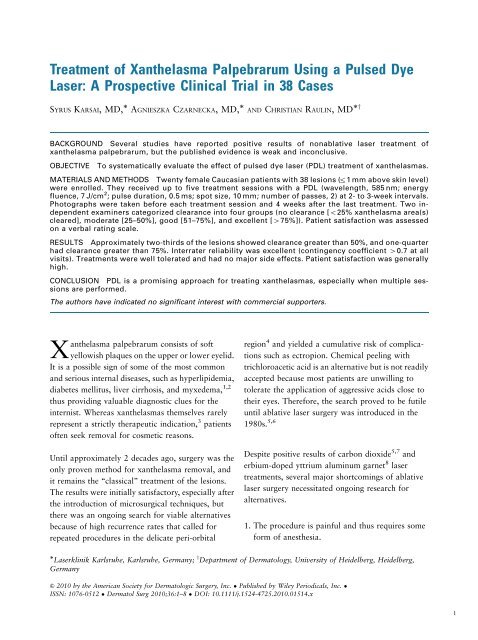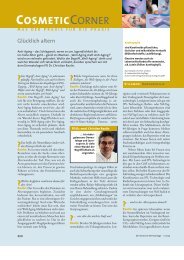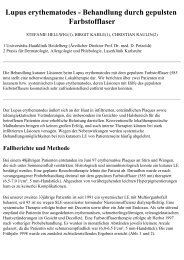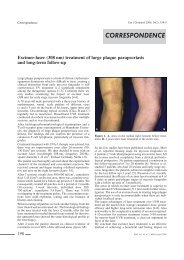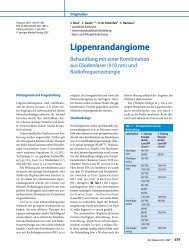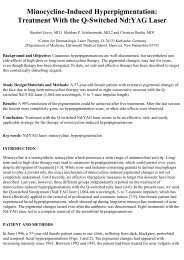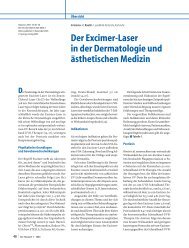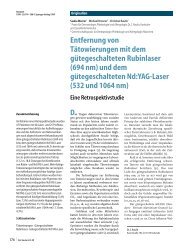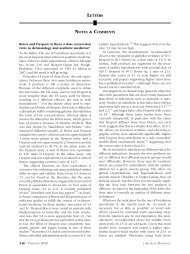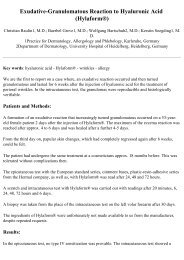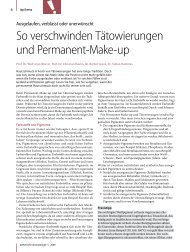Treatment of Xanthelasma Palpebrarum Using a Pulsed Dye Laser ...
Treatment of Xanthelasma Palpebrarum Using a Pulsed Dye Laser ...
Treatment of Xanthelasma Palpebrarum Using a Pulsed Dye Laser ...
- No tags were found...
You also want an ePaper? Increase the reach of your titles
YUMPU automatically turns print PDFs into web optimized ePapers that Google loves.
<strong>Treatment</strong> <strong>of</strong> <strong>Xanthelasma</strong> <strong>Palpebrarum</strong> <strong>Using</strong> a <strong>Pulsed</strong> <strong>Dye</strong><br />
<strong>Laser</strong>: A Prospective Clinical Trial in 38 Cases<br />
SYRUS KARSAI, MD, AGNIESZKA CZARNECKA, MD, AND CHRISTIAN RAULIN, MD y<br />
BACKGROUND Several studies have reported positive results <strong>of</strong> nonablative laser treatment <strong>of</strong><br />
xanthelasma palpebrarum, but the published evidence is weak and inconclusive.<br />
OBJECTIVE<br />
To systematically evaluate the effect <strong>of</strong> pulsed dye laser (PDL) treatment <strong>of</strong> xanthelasmas.<br />
MATERIALS AND METHODS Twenty female Caucasian patients with 38 lesions (r1 mm above skin level)<br />
were enrolled. They received up to five treatment sessions with a PDL (wavelength, 585 nm; energy<br />
fluence, 7 J/cm 2 ; pulse duration, 0.5 ms; spot size, 10 mm; number <strong>of</strong> passes, 2) at 2- to 3-week intervals.<br />
Photographs were taken before each treatment session and 4 weeks after the last treatment. Two independent<br />
examiners categorized clearance into four groups (no clearance [o25% xanthelasma area(s)<br />
cleared], moderate [25–50%], good [51–75%], and excellent [475%]). Patient satisfaction was assessed<br />
on a verbal rating scale.<br />
RESULTS Approximately two-thirds <strong>of</strong> the lesions showed clearance greater than 50%, and one-quarter<br />
had clearance greater than 75%. Interrater reliability was excellent (contingency coefficient 40.7 at all<br />
visits). <strong>Treatment</strong>s were well tolerated and had no major side effects. Patient satisfaction was generally<br />
high.<br />
CONCLUSION PDL is a promising approach for treating xanthelasmas, especially when multiple sessions<br />
are performed.<br />
The authors have indicated no significant interest with commercial supporters.<br />
<strong>Xanthelasma</strong> palpebrarum consists <strong>of</strong> s<strong>of</strong>t<br />
yellowish plaques on the upper or lower eyelid.<br />
It is a possible sign <strong>of</strong> some <strong>of</strong> the most common<br />
and serious internal diseases, such as hyperlipidemia,<br />
diabetes mellitus, liver cirrhosis, and myxedema, 1,2<br />
thus providing valuable diagnostic clues for the<br />
internist. Whereas xanthelasmas themselves rarely<br />
represent a strictly therapeutic indication, 3 patients<br />
<strong>of</strong>ten seek removal for cosmetic reasons.<br />
Until approximately 2 decades ago, surgery was the<br />
only proven method for xanthelasma removal, and<br />
it remains the ‘‘classical’’ treatment <strong>of</strong> the lesions.<br />
The results were initially satisfactory, especially after<br />
the introduction <strong>of</strong> microsurgical techniques, but<br />
there was an ongoing search for viable alternatives<br />
because <strong>of</strong> high recurrence rates that called for<br />
repeated procedures in the delicate peri-orbital<br />
region 4 and yielded a cumulative risk <strong>of</strong> complications<br />
such as ectropion. Chemical peeling with<br />
trichloroacetic acid is an alternative but is not readily<br />
accepted because most patients are unwilling to<br />
tolerate the application <strong>of</strong> aggressive acids close to<br />
their eyes. Therefore, the search proved to be futile<br />
until ablative laser surgery was introduced in the<br />
1980s. 5,6<br />
Despite positive results <strong>of</strong> carbon dioxide 5,7 and<br />
erbium-doped yttrium aluminum garnet 8 laser<br />
treatments, several major shortcomings <strong>of</strong> ablative<br />
laser surgery necessitated ongoing research for<br />
alternatives.<br />
1. The procedure is painful and thus requires some<br />
form <strong>of</strong> anesthesia.<br />
<strong>Laser</strong>klinik Karlsruhe, Karlsruhe, Germany; y Department <strong>of</strong> Dermatology, University <strong>of</strong> Heidelberg, Heidelberg,<br />
Germany<br />
& 2010 by the American Society for Dermatologic Surgery, Inc. Published by Wiley Periodicals, Inc. <br />
ISSN: 1076-0512 Dermatol Surg 2010;36:1–8 DOI: 10.1111/j.1524-4725.2010.01514.x<br />
1
PULSED DYE LASER TREATMENT OF XANTHELASMA PALPEBRARUM<br />
2. Ablative laser treatment causes an open wound,<br />
which makes the patient unable to work for several<br />
days and requires meticulous wound care.<br />
3. Because the risk <strong>of</strong> recurrence remains the same<br />
after surgical removal, it must also be assumed<br />
that procedures will have to be repeated. The risk<br />
<strong>of</strong> scarring that occurs when the subcutis is erroneously<br />
involved may be low in a single, meticulously<br />
performed procedure but accumulates<br />
over time. If scars form in the treatment area, the<br />
procedure per se is rendered useless, because cosmetic<br />
concerns are what brought the patient to the<br />
laser surgeon’s <strong>of</strong>fice in the first place.<br />
4. In cases <strong>of</strong> droopy lids (blepharochalasis), tissue<br />
ablation and the thermal effect leading to collagen<br />
shrinkage cause involuntary, uncontrollable, and<br />
asymmetric retractions (Figure 1).<br />
The perspective <strong>of</strong> nonablative laser treatment <strong>of</strong><br />
xanthelasma is intriguing, but however promising<br />
the results may be, treatment protocols and evaluation<br />
methods are inconsistent, 9–14 and evidence is<br />
too weak to draw valid conclusions and to extrapolate<br />
therapy recommendations. Therefore, we conducted<br />
a systematic trial <strong>of</strong> pulsed dye laser (PDL)<br />
treatment <strong>of</strong> xanthelasmas, using methods that were<br />
employed previously 9,10 so as to facilitate a comparison<br />
<strong>of</strong> the results.<br />
Materials and Methods<br />
Patients<br />
Figure 1. <strong>Xanthelasma</strong> palpebrarum on the right upper eyelid<br />
<strong>of</strong> a 56-year-old female patient before treatment (top);<br />
note the pronounced droopy eyelids. Clinical appearance 2<br />
months after a single carbon dioxide laser treatment (middle<br />
and bottom). The lesion was completely removed, but<br />
the laser-induced retractions and defects in the tissue lead<br />
to a cosmetically unacceptable result. The arrow points at<br />
the so-called ‘‘curtain sign’’ (bottom). The patient was referred<br />
to a plastic surgeon for blepharoplasty.<br />
Twenty consecutive female Caucasian patients (aged<br />
38–68, mean 53.0 7 8.5) with xanthelasma palpebrarum<br />
(elevation <strong>of</strong> r1 mm above skin level)<br />
were enrolled in the study. To ensure patient safety,<br />
the patients were not admitted if any <strong>of</strong> the following<br />
criteria were present: Fitzpatrick skin type IV to<br />
VI; marked ‘‘dark circles’’ (peri-orbital hyperpigmentation);<br />
sun exposure, tanning beds or tanning<br />
creams within 4 weeks before treatment; laser surgery<br />
within 12 weeks before treatment; hypersensitivity<br />
to light; photosensitizing medication (such as<br />
tetracycline or gold); anticoagulants; seizure disorders<br />
triggered by light; active localized infection;<br />
pregnancy; unreasonable treatment expectations;<br />
and inability or unwillingness to meet the treatment<br />
and follow-up criteria.<br />
Patients were given detailed information before the<br />
first treatment, including the risks, benefits, potential<br />
complications, and alternative treatments, and written<br />
informed consent to participate was obtained.<br />
The study complied with the Declaration <strong>of</strong> Helsinki<br />
and good clinical practice principles.<br />
2<br />
DERMATOLOGIC SURGERY
KARSAI ET AL<br />
<strong>Treatment</strong> Protocol<br />
Patients underwent up to five treatment sessions<br />
(average 3.9 7 1.0) with a PDL (V-Star, Cynosure<br />
Inc., Westford, MA) at intervals <strong>of</strong> 2 to 3 weeks.<br />
All treatments were performed without topical or<br />
systemic anesthesia or sedation. A cold-air cooling<br />
device was used to enhance patient comfort<br />
and epidermal protection (Cryo 5 set at level 4,<br />
Zimmer Medizin Systeme GmbH, Neu-Ulm,<br />
Germany). The treatment parameters were as follows:<br />
wavelength, 585 nm; energy fluence, 7 J/cm 2 ;<br />
pulse duration, 0.5 ms; spot size, 10 mm; number <strong>of</strong><br />
passes, 2. Pulses were delivered in a minimally<br />
overlapping manner, taking special care to avoid<br />
pulse stacking. To ensure consistency, all laser<br />
treatments were performed by the same physician<br />
(SK), who did not participate in the evaluation.<br />
Safety<br />
The patients’ eyes were protected by shells placed in<br />
contact with the eyeball. The ocular conjunctiva was<br />
anesthetized using oxybuprocaine hydrochloride<br />
anesthetic eye drops (Conjuncain EDO, Bausch &<br />
Lomb, Berlin, Germany) and protected using carbomer<br />
gel (Vidisic, Bausch & Lomb) before placing the shell.<br />
After each session, the treated area was cooled<br />
with ice packs for 10 minutes. All patients were<br />
instructed about the importance <strong>of</strong> not picking or<br />
scratching at treated sites. If crusting occurred, the<br />
patients were advised to apply an antibiotic ointment<br />
(Flammazine, Emra-Med Arzneimittel, Trittau,<br />
Germany) three times a day until the crusts fell <strong>of</strong>f.<br />
They were informed about proper sun protection<br />
and the use <strong>of</strong> broad-spectrum sunscreens <strong>of</strong> their<br />
choice (during the trial and for at least 4 weeks after<br />
the final treatment session).<br />
Evaluation<br />
Clearance: Before the first treatment, patients’<br />
serum lipid concentrations (total cholesterol, highdensity<br />
lipoprotein cholesterol, low-density lipoprotein<br />
cholesterol, triglycerides) were determined. All<br />
photographic documentation (en face and 451 oblique)<br />
was performed using the same digital camera (EOS<br />
350DwithMacroLensEF-S60mmf/2.8USM,<br />
Canon, Inc., Tokyo, Japan) set at a fixed distance from<br />
the patient’s face. A lens-mounted ring flash (Macro<br />
Ring Lite MR-14EX, Canon, Inc.) ensured even illumination<br />
<strong>of</strong> all parts <strong>of</strong> the face and the ability to<br />
examine subjects under controlled lighting.<br />
Before each treatment and 4 weeks after the final<br />
session, photographic documentation was repeated.<br />
Two independent dermatologists compared the total<br />
xanthelasma area in the follow-up photographic sets<br />
to the first set and rated the reduction <strong>of</strong> the lesion<br />
area in four categories:<br />
No clearance (o25% <strong>of</strong> the xanthelasma area(s)<br />
cleared);<br />
Moderate clearance (25–50% cleared);<br />
Good clearance (51–75% cleared);<br />
Excellent clearance (475% cleared).<br />
Photos were evaluated in a blinded fashion (i.e., the<br />
photographs were mixed intra-individually, and the<br />
examiners were unaware <strong>of</strong> whether the photographs<br />
were pre- or postoperative).<br />
Patient Satisfaction: Upon final examination, patients<br />
were asked to rate their overall satisfaction<br />
based on a verbal rating scale according to the following<br />
questions:<br />
‘‘How satisfied are you with the result <strong>of</strong> the<br />
treatment’’ (1 = not at all to 5 = very satisfied)<br />
‘‘Would you undergo the treatment again or recommend<br />
it to others’’ (1 = definitely not to<br />
5 = definitely)<br />
Side Effects: The investigator (SK) and the patients<br />
recorded the presence or absence <strong>of</strong> potential side<br />
effects (hyperpigmentation, hypopigmentation, blisters,<br />
crusts, weeping, drainage, atrophy, scars, and<br />
ectropion) and concomitant skin reactions (swelling,<br />
purpura).<br />
36:**:2010 3
PULSED DYE LASER TREATMENT OF XANTHELASMA PALPEBRARUM<br />
Statistical Analysis<br />
All data were analyzed using the SPSS/PC 1 s<strong>of</strong>tware<br />
(version 12.0 for Windows, SPSS, Inc., Chicago,<br />
IL) employing nonparametric tests (Wilcoxon<br />
signed rank test, Friedman test, Spearman rank<br />
correlation).<br />
The significance level was set to po.05. Descriptive<br />
statistics were also calculated (mean, standard deviation,<br />
median, minimum, maximum, numbers,<br />
percentage).<br />
Interrater reliability was assessed as a joint probability<br />
<strong>of</strong> agreement and by employing Cohen’s weighted<br />
kappa as a measure <strong>of</strong> conformity <strong>of</strong> ratings.<br />
Results<br />
Clearance<br />
The total number <strong>of</strong> treated xanthelasmas was 38<br />
(1–4 per patient), and the majority involved the upper<br />
lid (Table 1). Eighteen lesions were 5 to 10 mm in<br />
diameter, and 20 were 10 to 20 mm in diameter.<br />
The final examination typically indicated good<br />
clearance, and only a few lesions did not respond to<br />
TABLE 1. Location <strong>of</strong> Treated Lesions<br />
Location<br />
n (%)<br />
Left<br />
Right<br />
the therapy at all (Figure 2). Approximately twothirds<br />
<strong>of</strong> the lesions showed clearance greater than<br />
50%, and one-quarter had excellent clearance<br />
(475%) (e.g., see Figure 3). Clearance rate did not<br />
depend on the size <strong>of</strong> the skin lesions (data not<br />
shown).<br />
Three patients were lost to follow-up after the third<br />
treatment session; two <strong>of</strong> these patients had had<br />
excellent clearance <strong>of</strong> their xanthelasmas upon the<br />
last examination, pointing to satisfaction as the<br />
reason for dropping out.<br />
Improvement Between Follow-Up<br />
Examinations<br />
Sum <strong>of</strong><br />
Upper/<br />
Lower<br />
Upper 14 (36.8) 11 (28.9) 25 (65.7)<br />
Lower 8 (21.1) 5 (13.2) 13 (34.3)<br />
Sum <strong>of</strong> both<br />
sides<br />
22 (57.9) 16 (42.1) 38 (100.0)<br />
Whereas improvement after the first and second<br />
session was slight and statistically not significant, the<br />
Figure 2. Rate <strong>of</strong> clearance (depending on the examiner).<br />
4<br />
DERMATOLOGIC SURGERY
KARSAI ET AL<br />
TABLE 2. Average Clearance Depending on Time<br />
and Examiner (Significance in Comparison with<br />
the Previous Examination; Tied p-Values)<br />
Mean 7 Standard Deviation,<br />
p-value<br />
Time<br />
Examiner 1 Examiner 2<br />
Figure 3. <strong>Xanthelasma</strong> palpebrarum on the left and right<br />
upper eyelid <strong>of</strong> a 53-year-old female patient before treatment<br />
(top). Clinical appearance after 4 treatments with the<br />
pulsed dye laser (bottom) ( 75% <strong>of</strong> xanthelasma area<br />
cleared; for details, see Materials and Methods).<br />
After first<br />
session<br />
After second<br />
session<br />
After third<br />
session<br />
After fourth<br />
session<br />
After fifth<br />
session<br />
(when performed)<br />
Upon final examination<br />
1.00 7 0.69, n/a 0.89 7 0.68, n/a<br />
1.06 7 0.75, .08 0.94 7 0.66, .046<br />
1.33 7 0.91, .02 1.33 7 0.86, .002<br />
1.56 7 1.00, .01 1.75 7 0.94, .008<br />
2.45 7 0.52, .046 2.36 7 0.67, .046<br />
1.74 7 1.00, n/a 1.86 7 0.92, n/a<br />
No clearance = 0, moderate clearance = 1, good clearance = 2,<br />
excellent clearance = 3.<br />
n/a, not applicable.<br />
third and fourth treatment each showed a<br />
significant improvement over the previous<br />
examination, and so did the fifth in the patients<br />
who received it (n = 6; with a total <strong>of</strong> 11 lesions)<br />
(Table 2). In those patients, the last session<br />
yielded remarkable improvement, by almost<br />
an entire level on average, and the statistical<br />
significance makes this result all the more<br />
impressive, despite the fact that only 11 lesions<br />
were treated.<br />
Interrater Reliability<br />
Interrater reliability was excellent. The joint<br />
probability <strong>of</strong> agreement was between 76.5%<br />
and 95.2% (typically B90%), and Cohen’s weighted<br />
kappa was between 0.676 and 0.898 (Table 3).<br />
No site was assessed with a difference <strong>of</strong> more<br />
than one level. Most discrepancies occurred between<br />
no response and moderate; lesions with good<br />
or excellent response were classified almost<br />
unanimously.<br />
Correlation with Systemic Lipid Concentrations<br />
There was no correlation between systemic lipid<br />
concentrations and treatment response.<br />
Patient Satisfaction<br />
Patient satisfaction was generally high (Table 4), and<br />
only one patient expressed pr<strong>of</strong>ound dissatisfaction.<br />
TABLE 3. Interrater Reliability<br />
Time<br />
Joint probability<br />
<strong>of</strong> agreement<br />
(%)<br />
Cohen’s<br />
weighted<br />
kappa<br />
After first session 89.9 0.839<br />
After second session<br />
76.5 0.676<br />
After third session<br />
95.2 0.898<br />
After fourth session<br />
87.5 0.877<br />
After fifth session 90.9 0.845<br />
(when performed)<br />
Upon final examination<br />
91.2 0.867<br />
36:**:2010 5
PULSED DYE LASER TREATMENT OF XANTHELASMA PALPEBRARUM<br />
TABLE 4. Patients’ Assessment <strong>of</strong> <strong>Treatment</strong> Outcome<br />
Rating<br />
Side Effects<br />
<strong>Treatment</strong>-induced purpura (38/38 lesions) typically<br />
lasted for 10 to 12 days, and swelling (38/38 lesions)<br />
cleared in 2 to 5 days. There were no major side<br />
effects such as blisters, crusts, atrophy, scars, or<br />
ectropion. No patient reported drainage or weeping<br />
from the treated sites. Hyperpigmentation occurred<br />
in three <strong>of</strong> 38 lesions (7.9%) and was still present<br />
at the end <strong>of</strong> the final 4-week follow-up. Both<br />
patients were skin type II and were treated with<br />
broad-spectrum sunscreen.<br />
Discussion<br />
How satisfied<br />
are you with<br />
the treatment<br />
outcome <br />
Would you<br />
undergo the<br />
treatment<br />
again or recommend<br />
it<br />
to others y<br />
1, n (%) 1 (5.0) 1 (5.0)<br />
2, n (%) 2 (10.0) 1 (5.0)<br />
3, n (%) 3 (15.0) 3 (15.0)<br />
4, n (%) 8 (40.0) 7 (35.0)<br />
5, n (%) 6 (30.0) 8 (40.0)<br />
Average 7 standard<br />
deviation<br />
3.8 7 1.1 4.0 7 1.1<br />
Range from not satisfied at all (1) to very satisfied (5).<br />
y Range from definitely not (1) to definitely (5).<br />
To our knowledge, this is the first systematic trial <strong>of</strong><br />
treating xanthelasma palpebrarum with PDL. Previously,<br />
only a case report was published, and it<br />
showed encouraging findings. 11 In the present study,<br />
PDL treatment resulted in interim clearance rates<br />
greater than 50% in approximately two-thirds <strong>of</strong> the<br />
lesions without major side effects. The patients’ own<br />
assessment <strong>of</strong> the treatment outcome reflected the<br />
positive results.<br />
Selective photothermolysis <strong>of</strong> xanthelasma content<br />
in the strict sense <strong>of</strong> the term has not yielded convincing<br />
and conclusive results. In a previous study, 10<br />
we failed to reproduce positive findings with a<br />
Q-switched 1,064-nm neodymium-doped yttrium<br />
aluminum garnet laser published by Fusade. 9<br />
A morphological feature <strong>of</strong> xanthelasma is that the<br />
lipid-laden histiocytes are tightly attached to the<br />
walls <strong>of</strong> small hyperpermeable vessels. 15 Vascularspecific<br />
lasers may be able to induce coagulation<br />
within those vessels in the upper dermis, destroying<br />
the lipid-laden cells and preventing the leakage <strong>of</strong><br />
lipid compounds into the surrounding tissue. Studies<br />
based on this principle 11,12 have shown promising<br />
results and indicated that long-pulse treatment might<br />
turn out to be a viable alternative to ablative laser<br />
surgery. The positive results <strong>of</strong> the present trial reinforce<br />
this hypothesis. We would consider it promising<br />
to verify this mechanism using histological and<br />
electron microscope examination <strong>of</strong> tissue samples<br />
after the first few treatment sessions. At present, this<br />
information is available only for the argon laser, 16<br />
which is <strong>of</strong> limited value considering its inconclusive<br />
efficacy. 13,14<br />
For the time being, it is impossible to draft valid<br />
recommendations for a concrete evidence-based<br />
therapeutic procedure because only a few trials with<br />
a variety <strong>of</strong> different methods have been published.<br />
The wavelength, the number <strong>of</strong> sessions, and the<br />
pulse duration are the main variables. For example,<br />
the patient presented by Schönermark and Raulin 11<br />
was treated five times (wavelength, 585 nm; pulse<br />
duration, 0.35–0.45 ms; spot size, 5 mm; number <strong>of</strong><br />
passes, not declared). In the present study, we also<br />
observed the most pronounced effect after five sessions<br />
(wavelength, 585 nm; pulse duration, 0.5 ms;<br />
spot size, 10 mm; number <strong>of</strong> passes, 2), suggesting<br />
that further clinical clearance <strong>of</strong> lesions might be<br />
achieved given a sufficient number <strong>of</strong> additional<br />
treatments. In contrast, Berger and coworkers 12<br />
published a study in which the treatment was repeated<br />
only once or twice at 4- to 6-week intervals<br />
(wavelength, 532 nm; energy fluence,<br />
9 J/cm 2 ; pulse duration, 10 ms; spot size, 3 mm;<br />
number <strong>of</strong> passes, 2–3). Clearance was determined<br />
using a patient questionnaire and considered ‘‘satisfactory<br />
from an esthetic point <strong>of</strong> view’’ in all but two<br />
6<br />
DERMATOLOGIC SURGERY
KARSAI ET AL<br />
patients, leaving a wide area for interpretation and<br />
making it impossible to reproduce in independent<br />
studies, although it is likely that additional sessions<br />
would have continued to improve the clinical<br />
appearance in those patients. Furthermore, the<br />
extent to which the longer pulse duration in Berger’s<br />
study is responsible for the alleged difference in<br />
the number <strong>of</strong> sessions remains unresolved. Current<br />
evidence suggests that the microvessels surrounding<br />
the lipid-laden histiocytes are the main target<br />
<strong>of</strong> treatment, arguing for shorter pulse duration,<br />
leading to rapid heating within those small vessels.<br />
Eventually, we would encourage a split-face trial<br />
to allow a direct comparison <strong>of</strong> both laser devices,<br />
but apart from the aforementioned theoretical<br />
considerations, the PDL’s greater penetration depth<br />
and its larger spot size make it a better alternative.<br />
A larger spot size in particular permits faster<br />
and more effective treatment in dermatologic<br />
applications.<br />
Conclusions<br />
Based on our experience and in keeping with the<br />
limited amount <strong>of</strong> available literature, PDL therapy<br />
is probably the most promising method for plain<br />
xanthelasmas in terms <strong>of</strong> achieving good clearance<br />
and avoiding major side effects. The advantages <strong>of</strong><br />
this method are the option <strong>of</strong> repeating the application<br />
in cases <strong>of</strong> recurrence, easy handling in the<br />
delicate peri-orbital area, forgoing local and systemic<br />
anesthetics, and the low risk <strong>of</strong> scarring (even in<br />
widespread cases). It is advisable to begin treatment<br />
as soon as the condition is diagnosed because <strong>of</strong> the<br />
limited penetration depth <strong>of</strong> this laser device.<br />
Also, it might be promising to combine ablative and<br />
nonablative laser surgery when attempting to<br />
remove tuberous lesions. The deep penetration<br />
that incurs the risk <strong>of</strong> subcutis damage and subsequent<br />
scar formation can theoretically be avoided,<br />
because remnants <strong>of</strong> lesions after a carbon dioxide or<br />
erbium-doped yttrium aluminum garnet laser session<br />
can subsequently be treated with the PDL. The<br />
latter has been proven to be effective in the<br />
prevention 17 and treatment 18,19 <strong>of</strong> scars, further<br />
emphasizing the potential benefit <strong>of</strong> such a combined<br />
approach. Finally, we should investigate whether<br />
subpurpuric treatment parameters reducing<br />
the morbidity rate (purpura) are as effective as<br />
purpuric ones.<br />
Acknowledgments We would like to thank Drs.<br />
Laurenz Schmitt and Gudrun Pfirrmann for their<br />
excellent technical support during the treatment and<br />
evaluation phase <strong>of</strong> this trial.<br />
References<br />
1. Sibley C, Stone NJ. Familial hypercholesterolemia: a challenge <strong>of</strong><br />
diagnosis and therapy. Cleve Clin J Med 2006;73:57–64.<br />
2. Stawiski MA, Voorhees JJ. Cutaneous signs <strong>of</strong> diabetes mellitus.<br />
Cutis 1976;18:415–21.<br />
3. Rohrich RJ, Janis JE, Pownell PH. <strong>Xanthelasma</strong> palpebrarum: a<br />
review and current management principles. Plast Reconstr Surg<br />
2002;110:1310–4.<br />
4. Mendelson BC, Masson JK. <strong>Xanthelasma</strong>: follow-up on results<br />
after surgical excision. Plast Reconstr Surg 1976;58:535–8.<br />
5. Gladstone GJ, Beckmann H, Elson L. CO 2 laser excision <strong>of</strong><br />
xanthelasma lesions. Arch Ophthalmol 1985;103:440–2.<br />
6. Apfelberg DB. Summary <strong>of</strong> carbon dioxide laser usage in plastic<br />
surgery. Scand J Plast Reconstr Surg 1986;20:19–24.<br />
7. Raulin C, Schönermark MP, Werner S, et al. <strong>Xanthelasma</strong> palpebrarum:<br />
treatment with the ultrapulsed CO2 laser. <strong>Laser</strong>s Surg<br />
Med 1999;24:122–7.<br />
8. Borelli C, Kaudewitz P. <strong>Xanthelasma</strong> palpebrarum: treatment<br />
with the erbium: YAG laser. <strong>Laser</strong>s Surg Med 2001;29:260–4.<br />
9. Fusade T. <strong>Treatment</strong> <strong>of</strong> xanthelasma palpebrarum by 1,064-nm<br />
Q-switched Nd:YAG laser: a study <strong>of</strong> 11 cases. Br J Dermatol<br />
2008;158:84–7.<br />
10. Karsai S, Schmitt L, Raulin C. Is Q-switched neodymium-doped<br />
yttrium aluminium garnet laser an effective approach to treat<br />
xanthelasma palpebrarum Results from a clinical study in 76<br />
cases. Dermatol Surg 2009;35:1962–9.<br />
11. Schönermark MP, Raulin C. <strong>Treatment</strong> <strong>of</strong> xanthelasma palpebrarum<br />
with the pulsed dye laser. <strong>Laser</strong>s Surg Med 1996;19:336–9.<br />
12. Berger C, Kopera D. KTP laser coagulation for xanthelasma palpebrarum.<br />
J Dtsch Dermatol Ges 2005;3:775–9.<br />
13. Basar E, Oguz H, Ozdemir H, et al. <strong>Treatment</strong> <strong>of</strong> xanthelasma<br />
palpebrarum with argon laser photocoagulation. Argon laser and<br />
xanthelasma palpebrarum. Int Ophthalmol 2004;25:9–11.<br />
14. Hintschich C. Argon laser coagulation <strong>of</strong> xanthelasmas. Ophthalmologe<br />
1995;92:858–61.<br />
15. Braun-Falco O. The morphogenesis <strong>of</strong> xanthelasma palpebrarum.<br />
A cytochemical investigation. Arch Klin Exp Dermatol<br />
1970;238:292–307.<br />
36:**:2010 7
PULSED DYE LASER TREATMENT OF XANTHELASMA PALPEBRARUM<br />
16. Sampath R, Parmar D, Cree IA, et al. Histology <strong>of</strong> xanthelasma<br />
lesion treated by argon laser photocoagulation. Eye 1998;12:479–<br />
80.<br />
17. Nouri K, Jimenez GP, Harrison-Balestra C, et al. 585-nm pulsed<br />
dye laser in the treatment <strong>of</strong> surgical scars starting on the suture<br />
removal day. Dermatol Surg 2003;29:65–73.<br />
18. Karsai S, Roos S, Hammes S, et al. <strong>Pulsed</strong> dye laser: what’s new in<br />
non-vascular lesions J Eur Acad Dermatol Venereol<br />
2007;21:877–90.<br />
19. Bouzari N, Davis SC, Nouri K. <strong>Laser</strong> treatment <strong>of</strong> keloids and<br />
hypertrophic scars. Int J Dermatol 2007;46:80–8.<br />
Address correspondence and reprint requests to: Syrus<br />
Karsai, MD, DALM, <strong>Laser</strong>klinik Karlsruhe, Kaiserstr.<br />
104, DE-76133 Karlsruhe, Germany, or e-mail: info@<br />
raulin.de<br />
8<br />
DERMATOLOGIC SURGERY


